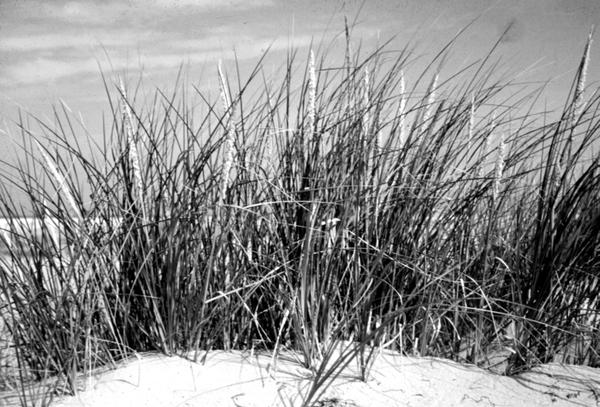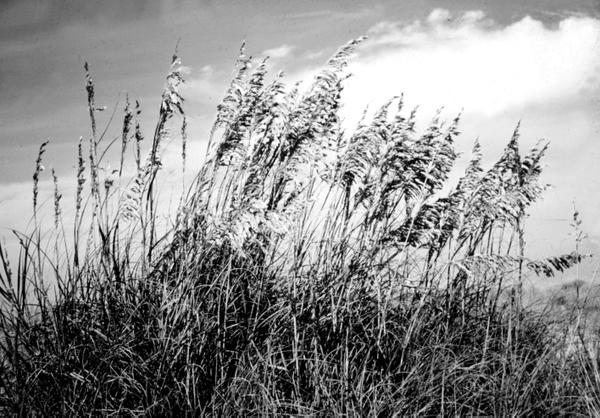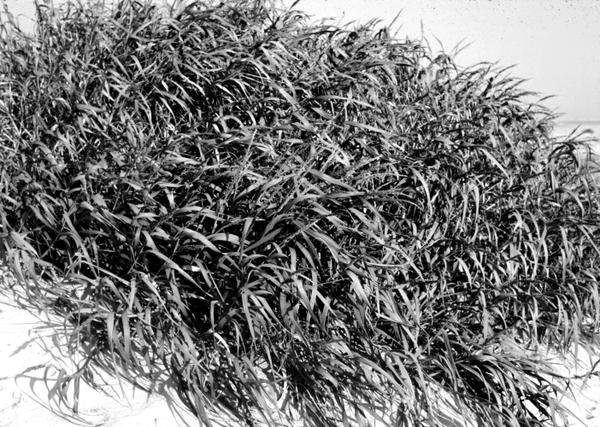Introduction
Picturesque though they are, coastal sand dunes serve a more important purpose than beauty. Dunes act as flexible barriers to ocean storm surges and waves, protect low-lying backshore areas, and help preserve the integrity of low barrier islands. In addition, they provide a habitat for many animals, including migratory birds. With proper planning and management, their functions may be enhanced. This publication discusses the features of coastal dunes and construction of new dunes using vegetation.
The Beach-Dune System: Functions, Values, and Limitations
Coastal barrier dunes are formed by wave and wind action. In North Carolina, waves bring sand to shore from the adjacent inner continental shelf, and it is transported landward by onshore winds. Obstacles, such as driftwood, a sand fence, or vegetation, reduce wind speed, causing sand to accumulate. As sand accumulates, plants adapted to the beach environment emerge, stabilizing the surface and promoting further dune formation. In the absence of stabilizing vegetation, blowing sand may drift into large "live" dunes that move back and forth with the wind, such as Jockey's Ridge near Kill Devil Hills.
Dunes formed as a result of establishing vegetation act as flexible barriers to storm tides and waves and serve as sand reservoirs for beach nourishment. During storms, sand erodes from the beach-dune system and redeposits as shallow sandbars offshore. In a stable beach-dune system, the sand moved offshore during storms is returned during calm weather. Thus, the dunes, beach, and near-shore sandbars act as a dynamic, integrated unit, often referred to a the beach-dune system.
Although dunes serve as temporary protective barriers during storm tides of short duration, they are not effective against persistent beach recession caused by rising sea level, migrating inlets, or changing shoreline dynamics. Therefore, they cannot be considered permanent structures that will "hold off the ocean."
The value of dunes and their fragile nature are often misunderstood or not appreciated. Excessive use often upsets the natural balance, damaging the vegetation and deteriorating the dune system. One of the earliest uses of dunes in North Carolina, which resulted in considerable damage, was overgrazing by livestock, including cattle, horses, and sheep. Today, shoreline development and pounding of dunes by feet and vehicles pose serious threats to dune vegetation and dune stability. Intensive beach use increases the need to restore, construct, protect, and manage dunes.
Restoration of Slightly Damaged Dunes
Dune sands are readily moved and shaped by wind and water action. Consequently, disturbed dunes revert rapidly to unstable conditions, regardless of their stage of development at the time of the disturbance. As a result, dune restoration usually begins with the establishment of pioneer plants.
Dunes that are only slightly damaged may be repaired by planting vegetation in bare areas, giving stressed grasses a judicious amount of fertilizer, and protecting the area from trampling and traffic.
Vegetation is critical to dune formation and stabilization. Without vegetation, blowing sand will migrate inland.
Selection of plant species is of paramount importance when restoring vegetation in bare areas of existing dunes. Dune plants must be able to survive sand blasting, sand burial, salt spray, saltwater flooding, heat, drought, and a limited nutrient supply. Only a few plant species can tolerate these stresses.
Dune Grasses
Perennial grasses are the primary stabilizers of frontal dune systems along the Atlantic and Gulf Coasts. The North Carolina coast is a transition zone between the northern-dominant American beachgrass and the southern-dominant sea oats. Bitter panicum or "running beachgrass" is also an important grass on frontal dunes in North Carolina. A woody shrub, seashore elder, grows well on frontal dunes and may be transplanted to add diversity to the dune system. A fourth grass, saltmeadow cordgrass, is not a true dune grass, but often traps sand to initiate dune growth. Saltmeadow cordgrass grows well in low, moist areas such as sand flats and high salt marshes. It is more salt- and flood-tolerant than the dune grasses. Planting a combination of several of these species can enhance the beach-dune system's diversity and long-term viability.
American beachgrass (Ammophila breviligulata)
American beachgrass is a cool-season dune grass native to the North, Mid-Atlantic, and Great Lakes coasts. North Carolina is at the southern end of its natural range. American beachgrass is a vigorous, upright grass that grows in dense clumps and is capable of rapid lateral spread by runners. Hence, it is widely used for initial stilling of blowing sand. It is easily recognizable by its dense, cylindrical spikes or seed heads (Figure 1). Several characteristics make American beachgrass suitable for dune building and stabilization in North Carolina:
- Quick establishment and effective trapping of sand the first growing season.
- Ease of harvest, storage, and transplanting, with an excellent survival rate.
- Commercial availability from nurseries at a low cost.
Recommended cultivars include Hatteras, Bogue, and Cape. Hatteras is a fine-leaf type that produces good results in the Carolinas. Bogue is another selection being used in the state. Cape, a northern strain that declines rapidly after the first growing season, is not recommended. Hatteras and Bogue are both available from commercial producers.
After establishment, American beachgrass will grow through as much as 4 feet of sand accumulation during one growing season. Although it grows quickly where sand accumulates on the seaward dune edge, it tends to die out behind the the dune crest after only a few years. This die-out is caused by climatic effects, fungal disease, and insects. Dead patches of beachgrass should be replaced with sea oats, bitter panicum, or seashore elder. To further increase the diversity and stability of the beach-dune system, sea oats and bitter panicum should be included in beachgrass plantings.
Because American beachgrass is a cool-season grass, the best planting dates are November through March. Plant small areas by hand using a dibble to open a hole 1 inch in diameter and 8 to 10 inches deep. Pack sand firmly around the plants after they are placed in the holes. Space the plants 18 to 24 inches apart at the crest of the dune and increase the spacing to 2 feet and then to 3 feet for several rows on each side of the crest.
Sea oats (Uniola paniculata)
Sea oats are a warm-season grass, native to coastal dunes from the Virginia Capes to Mexico. The plant's striking appearance, especially in bloom or fruiting, has made legal protection necessary in some areas to avoid excessive harvest (Figure 2). Due to an extensive root system, sea oats persist both seaward of the dune and behind the dune crest. Other characteristics include:
- Vigor and drought tolerance.
- Effective trapping of sand.
- Low incidence of pests.
- Excellent persistence.
- Tolerance to a limited supply of nutrients.
Planting stock may be acquired as seedlings from commercial producers, or, with permission on private property, transplants can be dug from existing stands. The best transplants are 1- to 3-year-old seedlings often found in small clusters seaward of the frontal dune.
Although sea oats provide the best long-term stability, the grass does not spread as rapidly as American beachgrass, and its slow lateral spread results in steep dune slopes. It should be planted in conjunction with American beachgrass or bitter panicum because of their more rapid spread and lower cost per plant.
Planting methods and spacing for sea oats are similar to those described for American beachgrass. Because sea oats are a warm-season grass, the best planting dates are March through June.
Bitter panicum (Panicum amarum)
Bitter panicum or "running beachgrass" is a warm-season grass found on dunes from New England to Mexico. It is useful for inclusion in American beachgrass and sea oats plantings to increase plant diversity. A wide variety of species is available, with variable stem sizes and growth characteristics (Figure 3). Although bitter panicum grows and multiplies relatively well in field nurseries, it is not as widely available as American beachgrass. Commercial availability is limited, and plants may have to be obtained by thinning local stands.
Bitter panicum will root at each node on the stem so it may be planted by placing runners in a trench 6 to 8 inches deep and covering the runners with sand. Leave one-third of the upper shoot out of the ground. The best transplanting dates are March through May.
Seashore elder (Iva imbricata)
Seashore elder is a low-growing, woody shrub adapted to frontal dunes (Figure 4). It spreads both by seed and vegetatively, as roots develop on stems buried by sand. It adds diversity to the landscape and is useful for planting where American beachgrass has died out.
Plants can be obtained by collecting and rooting the cuttings, or rooted stems may be dug from around existing plants. Seedlings are often found around older plants and in drift lines. Planting in early spring is usually the most successful.
Saltmeadow cordgrass (Spartina patens)
Saltmeadow cordgrass is useful for planting in low areas subject to flooding during storms. Its range includes all of the Atlantic and Gulf Coasts of the United States. Saltmeadow cordgrass often initiates new dunes on low flats that may later become occupied by plants better adapted to dry conditions.
Seedlings are commercially available from wetland plant nurseries. Plants can also be obtained by digging from young open stands where plants are vigorous. Planting methods and spacing are similar to those described for American beachgrass. The best planting dates are March through May.
Fertilization of Dune Vegetation
Dune sand is relatively low in plant nutrients, and dune plants are adapted to this condition. However, small amounts of nutrients, primarily nitrogen and phosphorus, supplied by commercial fertilizers, are useful for promoting rapid establishment of transplants and encouraging existing vegetation. Fertilizer may also be needed for periodic maintenance. Other plant nutrients are normally supplied from soil or salt spray.
Fertilizers should be not be used indiscriminately in the beach and dune area. Excess amounts may damage the development of diverse and stable plant communities and increase the occurrence of plant diseases. Excess nitrogen also may leach through beach sand and pollute groundwater.
Suggested rates and timing for dune fertilization are listed in Table 1 and Table 2. During the first growing season, fertilizer should supply nitrogen at the rate of 150 to 200 pounds N per acre and phosphorus at the rate of 50 to 60 pounds P2O5 per acre, which converts to about 3.5 to 4.5 pounds N per 1,000 square feet and 1.0 to 1.5 pounds P2O5 per 1,000 square feet. This should be split into three equal applications.
Fertilizer with a ratio of 3 parts N to 1 part P2O5 is ideal, but many fertilizer materials can be used to supply these rates. The need for fertilizer after the first year varies with location and can be determined by the appearance of the grass. Fertilizer materials and rates suggested in the table are a mixed fertilizer (10-10-10) and ammonium nitrate because these materials are readily available at farm and garden stores.
The suggested dates of fertilization are different for American beachgrass, sea oats, and bitter panicum. In mixed plantings, follow the fertilizer dates recommended for American beachgrass for the first two years. In later years, fertilize to favor sea oats and bitter panicum.
| Date | First Year | Second Year | Subsequent Years (if needed) |
|---|---|---|---|
| March 15 | 10lb 10-10-10 | 10lb 10-10-10 | |
| April 15 | 15lb 10-10-10 | ||
| June 15 | 4lb ammonium nitrate | ||
| September 1 | 4lb ammonium nitrate | 3lb ammonium nitrate | |
| 1 Rates are pounds per 1,000 square feet. Multiply by 43.56 to express rates in pounds per acre.↵ | |||
| Date | First Year | Second Year (if needed) |
Subsequent Years (if needed) |
|---|---|---|---|
| April 15 | 10lb 10-10-10 | 10lb 10-10-10 | |
| May 1 | 15lb 10-10-10 | ||
| June 15 | 4lb ammonium nitrate | ||
| July 1 | 3lb ammonium nitrate | ||
| August 1 | 4lb ammonium nitrate | ||
| 1 Rates are pounds per 1,000 square feet. Multiply by 43.56 to express rates in pounds per acre.↵ | |||
Construction of Dunes
When barrier dunes are absent, they may be rebuilt by bulldozing, dredging, or, preferably, by encouraging the natural process of dune building by trapping blowing sand with sand fences and vegetation. Building dunes with vegetation is more economical than using heavy equipment and discourages placement of the dune too close to the ocean or in other unsuitable locations.
Bulldozing and Dredging
Bulldozing and dredging are extremely expensive as well as damaging to the coastal environment. Usually these activities only result in short-term benefits and will need to be continued in the future.
Sand Fences and Vegetation
Barrier dunes are best located as far from the ocean as practical to allow for normal ocean tidal fluctuations. As the dune accumulates sand, it expands seaward, allowing plants to spread into freshly deposited sand. Some severely eroding beaches do not have sufficient space to successfully use vegetation for dune building. Where adequate distance exists between the ocean and property to be protected, well-vegetated dunes will provide valuable protection from storm waves.
The first step to dune establishment is providing a barrier to trap sand. Sand fences create areas of lower wind speed both in front of and behind the fence, which encourages sand deposition. The amount of sand trapped depends on the fence height, the size of spaces between fence slats, and the wind speed. Wooden slat fences are most commonly used and are generally preferable to fabric fences.
The initial dune crest is located by installing a 2-foot-high sand fence several hundred feet behind and parallel to the high tide line to accumulate wind-blown sand. Install the fence several months before transplanting vegetation to allow the sand to accumulate without burying the transplants. For additional options in establishing dunes with fencing, contact your county Extension agent, regional office of the North Carolina Division of Coastal Management, or the North Carolina Sea Grant office in Raleigh. Sand fences should be avoided in areas where sea turtles are likely to nest.
Plant small areas and steep slopes by hand, as described in the earlier section on the Restoration of Slightly Damaged Dunes. Plant large, flat areas with tractor-drawn tobacco or vegetable transplanters with extended planting shoes to make furrows 8 to 10 inches deep. Space the furrows at least 18 inches apart. When building a dune, plants should be closely spaced, 18 inches by 18 inches, in several rows where the crest of the dune is to be located. Then spacing should be increased to 2 feet and then 3 feet for several rows on each side to allow sand to penetrate to the center of the planting.
Protection of Dunes
Although dune plants tolerate harsh beach conditions, they cannot withstand foot and vehicular traffic. These activities crush plant shoots and roots. Trampling by pedestrians and traffic such as four-wheel vehicles and trail bikes often lead to greater sand removal by wind. In addition, soil compaction often results from vehicular traffic and decreases water infiltration, leading to erosion from rain and increased damage during droughts. Restricting or banning access to dunes can reduce the need for other sand control measures. However, some dunes will have to bear traffic, and to protect them, crosswalks and beach access areas should be designated.
Conclusion
Human activity has accelerated the loss of dune vegetation along North Carolina beaches. Recreational and commercial development, off-road vehicles, and population pressures associated with urban growth in coastal areas have altered the natural seashore. The building of streets and structures near the sea disrupts normal beach and dune processes. The procedures recommended here can help restore, enhance, and protect dune vegetation.
Recommended Readings
Broome, Seneca and Woodhouse. Building and Stabilizing Coastal Dunes with Vegetation. UNC Sea Grant College Publication, UNC-SG-82-05. June 1982.
Pilkey, Neal, Pilkey and Riggs. 1982. From Currituck to Calabash: Living with North Carolina's Barrier Islands. Durham, NC: Duke University Press.
This publication replaces publication number AG-591.
Publication date: March 17, 2015
Reviewed/Revised: Nov. 19, 2025
AG-439-84
N.C. Cooperative Extension prohibits discrimination and harassment regardless of age, color, disability, family and marital status, gender identity, national origin, political beliefs, race, religion, sex (including pregnancy), sexual orientation and veteran status.




